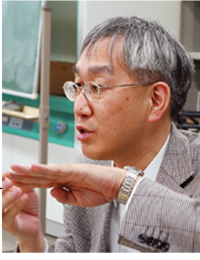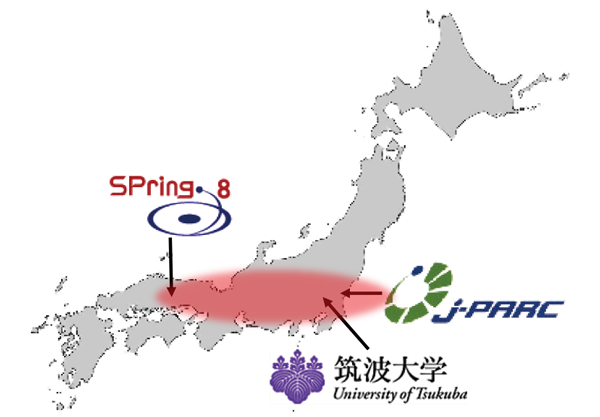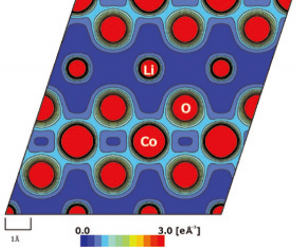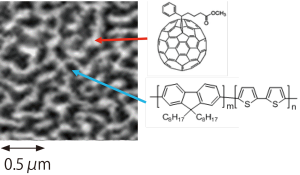他のメンバー : 関場 大一郎 後藤 博正 黒田 眞司 佐々木 正洋 山村 泰久 山田 洋一 志賀 拓也 小林 航 谷本 久典 渡辺 紀生 都甲 薫 二瓶 雅之 柏木 隆成 末益 崇 櫻井 岳暁 齋藤 一弥
キーワード: 量子ビーム、放射光、中性子、エネルギー材料、グリーン材料
 新材料、新デバイスの研究開発には、それらを特徴づける計測が不可欠です。その一つの手法として、電磁波(可視光~ X線)を用いた材料分析法があります。通常の実験室に設置できる装置もありますが、シンクロトロン放射光(SR)を利用した技術も盛んに用いられています。SRには、計測に適した波長(エネルギー)のX線を選択でき、微小領域に照射できるという特徴だけでなく、光源のパルス性を利用することで高い時間分解能で材料の変化をとらえることができる長所もあります。「量子ビーム」ユニットでは、大型放射光施設SPring-8(兵庫県佐用郡)、KEK-PF(高エネルギー加速器研究機構フォトンファクトリー/つくば市)、大強度陽子加速器施設J-PARK(茨城県東海村)(図1)や海外の共同利用施設の電磁波や中性子を利用して物質科学の新たな展開を開こうとしています。
新材料、新デバイスの研究開発には、それらを特徴づける計測が不可欠です。その一つの手法として、電磁波(可視光~ X線)を用いた材料分析法があります。通常の実験室に設置できる装置もありますが、シンクロトロン放射光(SR)を利用した技術も盛んに用いられています。SRには、計測に適した波長(エネルギー)のX線を選択でき、微小領域に照射できるという特徴だけでなく、光源のパルス性を利用することで高い時間分解能で材料の変化をとらえることができる長所もあります。「量子ビーム」ユニットでは、大型放射光施設SPring-8(兵庫県佐用郡)、KEK-PF(高エネルギー加速器研究機構フォトンファクトリー/つくば市)、大強度陽子加速器施設J-PARK(茨城県東海村)(図1)や海外の共同利用施設の電磁波や中性子を利用して物質科学の新たな展開を開こうとしています。

図1:量子ビーム光源施設(国内)
無機材料の起源に迫る

図2:LiCoO2 の電子密度構造
世界で初めてエピタキシャル膜作成に成功した、垂直磁気記録材料であるCo4N系薄膜を放射光(SPring-8)の偏光性を利用したX線磁気円二色性分光(XMCD)で解析した結果、室温で垂直磁気異方性をもつことが分かりました。この磁性材料は、ユビキタス元素(Fe, Co, Mn, Nといった「どこにでもある元素」)だけで構成されており、磁気メモリの低コスト化が期待できます。この研究により、伊藤啓太氏は博士課程在学中に権威あるSPRUC 2013 Young Scientist Awardを受賞しました。また、リチウムイオン電池材料であるLiCoO2の電子密度レベルの構造解析(図2)により、この化合物がイオン結合で形成されていることが分かりました。エネルギー材料の結合様式の解明は、高性能材料の設計指針や劣化機構の解明に大いに貢献できると期待できます。デバイスの稼動状態での観察(オペランド計測)に適用できれば、一層の応用展開が可能となります。
有機材料の可能性を開拓する

図3:有機薄膜太陽電池の分子構造
有機薄膜太陽電池はドナー性分子とアクセプター性分子がナノレベルのドメイン構造を形成し、高い光電エネルギー変換効率を示します。KEK-PFの走査型軟X線透過顕微鏡(STXM)で太陽電池薄膜形態を詳細に調べたところ、ドメイン内で2つの分子が混合していることが明らかとなりました。(図3)薄膜形態の解明は、高効率太陽電池の設計指針や劣化機構の解明に大いに貢献します。
本リサーチユニットでは、ユーザーとして大型共同利用設備を利用させてもらうことで、新しい解析法を武器に材料科学(マテリアルス・サイエンス)に切り込んでいこうとしています。今後は、空間的・時間的により高分解能なイメージング手法を用いて、新材料の性質を同定することで社会貢献できればと考えています。さらに、国際テニュアトラック制度を活用した国際研究連携、大学院研究の強化を図ろうとしています。
社会への貢献・実績
● Fe, Co, Mn, Nのみから構成される磁性材料を発見(Appl. Phys. Lett. 2011)
● リチウムイオン電池材料の結合様式を解明(Appl. Phys. Express 2011)
● 有機薄膜太陽電池のドメイン内分子混合の発見(Appl. Phys. Express. 2014)
● 新しい光記録効果の発見(Appl. Phys. Lett. 2007)
● 国際物質科学研究拠点の形成へ
● TIA-nano(つくばイノベーションアリーナ)連携の推進
取材:平成27年3月25日
Exploring a new dimension of materials science through utilization of frontier quantum beam technology
Unit members : Sekiba, Daiichiro Goto, Hiromasa Kuroda, Shinji Sasaki, Masahiro Yamamura, Yasuhisa Yamada, Yoichi Shiga, Takuya Kobayashi, Wataru Tanimoto, Hisanori Watanabe, Norio Toko, Kaoru Nihei, Masayuki Kashiwagi, Takanari Suemasu, Takashi SAKURAI, TAKEAKI Saito, Kazuya
Unit name: Quantum Beam
Key words: quantum beam, synchrotron radiation, neutron, energy materials, green materials
 For R&D on new materials and devices, measurement for their characterization is indispensable. One tool for this purpose is the analysis of materials with electromagnetic waves (visible ray to X-ray). Some devices can be installed even at ordinary laboratories, but technology involving synchrotron radiation (SR) is also used frequently. SR has the characteristics of enabling selection of X-rays of a wavelength (energy) suitable for measurement, and allowing irradiation of very small areas. In addition, it has the advantage of enabling detection of changes in materials with high temporal resolution if pulsation of the light source is utilized. The “Quantum Beam” Unit is exploring a new dimension of materials science through utilization of electromagnetic waves and neutrons at the large synchrotron radiation facility SPring-8 (Sayo Gun, Hyogo Prefecture), KEK-PF (High Energy Accelerator Research Organization Photon Factory, Tsukuba City), J-PARK (Japan Photon Accelerator Research Complex, Tokai Village, Ibaraki Prefecture) (Fig. 1) and overseas facilities for joint use.
For R&D on new materials and devices, measurement for their characterization is indispensable. One tool for this purpose is the analysis of materials with electromagnetic waves (visible ray to X-ray). Some devices can be installed even at ordinary laboratories, but technology involving synchrotron radiation (SR) is also used frequently. SR has the characteristics of enabling selection of X-rays of a wavelength (energy) suitable for measurement, and allowing irradiation of very small areas. In addition, it has the advantage of enabling detection of changes in materials with high temporal resolution if pulsation of the light source is utilized. The “Quantum Beam” Unit is exploring a new dimension of materials science through utilization of electromagnetic waves and neutrons at the large synchrotron radiation facility SPring-8 (Sayo Gun, Hyogo Prefecture), KEK-PF (High Energy Accelerator Research Organization Photon Factory, Tsukuba City), J-PARK (Japan Photon Accelerator Research Complex, Tokai Village, Ibaraki Prefecture) (Fig. 1) and overseas facilities for joint use.

Fig. 1: Quantum beam source facility (domestic)
Approaching the origin of inorganic materials

Fig. 2: Electron density structure of LiCoO2
Co4N-based film, which is a vertical magnetic recording material assuming the form of an epitaxial membrane for the first time in the world, was analyzed by X-ray magnetic circular dichroism (XMCD), making use of the polarization property of synchrotron radiation (SPring-8). The analysis revealed that this material had vertical magnetic anisotropy at room temperature. This magnetic material is composed of only ubiquitous elements, such as Fe, Co, Mn, and N, and is expected to reduce the cost of magnetic memories. For this research. Mr. Keita Ito received the prestigious SPRUC 2013 Young Scientist Award while he was a graduate student. Furthermore, structural analysis of the electron density level of LiCo2 (a material for lithium ion batteries) revealed that this compound is formed by ionic bonds. Clarification of the binding style of energy materials is expected to contribute greatly to preparation of design guidelines for high performance materials and to elucidate their degradation mechanism. If it can be applied to observation (operand measurement) of devices while they are working, the scope of its application will further expand.
Exploring possibilities of organic materials

Fig. 3: Molecular structure of an organic thin-film solar cell
Organic thin-film solar cells form a nano-level domain structure made of donor molecules and acceptor molecules, exhibits a high optoelectric energy conversion efficiency. When the solar cell’s thin film was morphologically examined in detail with KEK-PF’s scanning transmission X-ray microscope (STXM), a mixture of two molecules within the domain was revealed (Fig. 3). Morphological clarification of the thin film contributes greatly to preparation of design guidelines of high efficiency solar cells, and elucidation of their degradation mechanism.
Our Research Unit plans to explore new dimensions of materials science using new analytical methods as a weapon through utilization of large outside facilities for joint use. From now on, we will use imaging techniques of higher spatial and temporal resolution for the purpose of identifying the properties of new materials so that we can contribute to society. Furthermore, we will reinforce international research linkage, making use of the global tenure tracking system and strengthen education at our graduate school.
Social contributions and achievements
– Discovery of magnetic materials made of only Fe, Co, Mn, and N (Appl. Phys. Lett. 2011)
– Clarification of the binding style of lithium ion battery materials (Appl. Phys. Express 2011)
– Detection of molecule mixture within the domain of organic thin-film solar cell (Appl. Phys. Express. 2014)
– Discovery of new optical recording effect (Appl. Phys. Lett. 2007)
– Toward establishment of a global materials science research core
– Promotion of linkage to TIA-nano (Tsukuba Innovation Arena)
Interviewed on March 25, 2015
